[English] 日本語
 Yorodumi
Yorodumi- PDB-7nmi: Transactivation domain of p53 in complex with S100P, using annexi... -
+ Open data
Open data
- Basic information
Basic information
| Entry | Database: PDB / ID: 7nmi | ||||||
|---|---|---|---|---|---|---|---|
| Title | Transactivation domain of p53 in complex with S100P, using annexin A2 as crystallization chaperone | ||||||
 Components Components |
| ||||||
 Keywords Keywords | PROTEIN BINDING / S100P / p53 / annexin A2 / protein-protein interaction / Ca2+-binding protein | ||||||
| Function / homology |  Function and homology information Function and homology informationAnxA2-p11 complex / membrane raft assembly / positive regulation of receptor-mediated endocytosis involved in cholesterol transport / positive regulation of vacuole organization / phospholipase A2 inhibitor activity / positive regulation of low-density lipoprotein particle clearance / positive regulation of vesicle fusion / myelin sheath adaxonal region / negative regulation of low-density lipoprotein particle receptor catabolic process / positive regulation of plasma membrane repair ...AnxA2-p11 complex / membrane raft assembly / positive regulation of receptor-mediated endocytosis involved in cholesterol transport / positive regulation of vacuole organization / phospholipase A2 inhibitor activity / positive regulation of low-density lipoprotein particle clearance / positive regulation of vesicle fusion / myelin sheath adaxonal region / negative regulation of low-density lipoprotein particle receptor catabolic process / positive regulation of plasma membrane repair / positive regulation of plasminogen activation / PCSK9-AnxA2 complex / cadherin binding involved in cell-cell adhesion / cornified envelope / Schmidt-Lanterman incisure / vesicle budding from membrane / plasma membrane protein complex / calcium-dependent phospholipid binding / osteoclast development / negative regulation of receptor internalization / Dissolution of Fibrin Clot / negative regulation of helicase activity / Loss of function of TP53 in cancer due to loss of tetramerization ability / Regulation of TP53 Expression / S100 protein binding / signal transduction by p53 class mediator / negative regulation of G1 to G0 transition / negative regulation of glucose catabolic process to lactate via pyruvate / Transcriptional activation of cell cycle inhibitor p21 / regulation of intrinsic apoptotic signaling pathway by p53 class mediator / negative regulation of pentose-phosphate shunt / ATP-dependent DNA/DNA annealing activity / Activation of NOXA and translocation to mitochondria / regulation of cell cycle G2/M phase transition / oligodendrocyte apoptotic process / negative regulation of miRNA processing / intrinsic apoptotic signaling pathway in response to hypoxia / regulation of fibroblast apoptotic process / collagen fibril organization / positive regulation of thymocyte apoptotic process / oxidative stress-induced premature senescence / regulation of tissue remodeling / positive regulation of mitochondrial membrane permeability / mRNA transcription / bone marrow development / vesicle membrane / positive regulation of programmed necrotic cell death / circadian behavior / T cell proliferation involved in immune response / regulation of mitochondrial membrane permeability involved in apoptotic process / germ cell nucleus / RUNX3 regulates CDKN1A transcription / glucose catabolic process to lactate via pyruvate / epithelial cell apoptotic process / TP53 Regulates Transcription of Death Receptors and Ligands / Activation of PUMA and translocation to mitochondria / TP53 regulates transcription of additional cell cycle genes whose exact role in the p53 pathway remain uncertain / regulation of DNA damage response, signal transduction by p53 class mediator / histone deacetylase regulator activity / negative regulation of glial cell proliferation / Regulation of TP53 Activity through Association with Co-factors / negative regulation of neuroblast proliferation / mitochondrial DNA repair / T cell lineage commitment / Formation of Senescence-Associated Heterochromatin Foci (SAHF) / ER overload response / phosphatidylserine binding / thymocyte apoptotic process / B cell lineage commitment / TP53 Regulates Transcription of Caspase Activators and Caspases / cardiac septum morphogenesis / negative regulation of mitophagy / negative regulation of DNA replication / entrainment of circadian clock by photoperiod / microvillus membrane / negative regulation of telomere maintenance via telomerase / Zygotic genome activation (ZGA) / positive regulation of release of cytochrome c from mitochondria / PI5P Regulates TP53 Acetylation / Association of TriC/CCT with target proteins during biosynthesis / necroptotic process / TP53 Regulates Transcription of Genes Involved in Cytochrome C Release / positive regulation of receptor recycling / TFIID-class transcription factor complex binding / SUMOylation of transcription factors / TP53 regulates transcription of several additional cell death genes whose specific roles in p53-dependent apoptosis remain uncertain / intrinsic apoptotic signaling pathway by p53 class mediator / rRNA transcription / negative regulation of reactive oxygen species metabolic process / Transcriptional Regulation by VENTX / basement membrane / cellular response to UV-C / replicative senescence / general transcription initiation factor binding / positive regulation of exocytosis / transition metal ion binding / cellular response to actinomycin D / intrinsic apoptotic signaling pathway in response to endoplasmic reticulum stress / positive regulation of RNA polymerase II transcription preinitiation complex assembly / neuroblast proliferation Similarity search - Function | ||||||
| Biological species |  Homo sapiens (human) Homo sapiens (human) | ||||||
| Method |  X-RAY DIFFRACTION / X-RAY DIFFRACTION /  SYNCHROTRON / SYNCHROTRON /  MOLECULAR REPLACEMENT / Resolution: 2.1 Å MOLECULAR REPLACEMENT / Resolution: 2.1 Å | ||||||
 Authors Authors | Ecsedi, P. / Nyitray, L. | ||||||
| Funding support |  Hungary, 1items Hungary, 1items
| ||||||
 Citation Citation |  Journal: To Be Published Journal: To Be PublishedTitle: Transactivation domain of p53 in complex with S100P using annexin A2 as a crystallization chaperone Authors: Ecsedi, P. / Nyitray, L. | ||||||
| History |
|
- Structure visualization
Structure visualization
| Structure viewer | Molecule:  Molmil Molmil Jmol/JSmol Jmol/JSmol |
|---|
- Downloads & links
Downloads & links
- Download
Download
| PDBx/mmCIF format |  7nmi.cif.gz 7nmi.cif.gz | 228.5 KB | Display |  PDBx/mmCIF format PDBx/mmCIF format |
|---|---|---|---|---|
| PDB format |  pdb7nmi.ent.gz pdb7nmi.ent.gz | 181.1 KB | Display |  PDB format PDB format |
| PDBx/mmJSON format |  7nmi.json.gz 7nmi.json.gz | Tree view |  PDBx/mmJSON format PDBx/mmJSON format | |
| Others |  Other downloads Other downloads |
-Validation report
| Summary document |  7nmi_validation.pdf.gz 7nmi_validation.pdf.gz | 443.9 KB | Display |  wwPDB validaton report wwPDB validaton report |
|---|---|---|---|---|
| Full document |  7nmi_full_validation.pdf.gz 7nmi_full_validation.pdf.gz | 450.2 KB | Display | |
| Data in XML |  7nmi_validation.xml.gz 7nmi_validation.xml.gz | 22 KB | Display | |
| Data in CIF |  7nmi_validation.cif.gz 7nmi_validation.cif.gz | 32 KB | Display | |
| Arichive directory |  https://data.pdbj.org/pub/pdb/validation_reports/nm/7nmi https://data.pdbj.org/pub/pdb/validation_reports/nm/7nmi ftp://data.pdbj.org/pub/pdb/validation_reports/nm/7nmi ftp://data.pdbj.org/pub/pdb/validation_reports/nm/7nmi | HTTPS FTP |
-Related structure data
| Related structure data |  1xjlS S: Starting model for refinement |
|---|---|
| Similar structure data |
- Links
Links
- Assembly
Assembly
| Deposited unit | 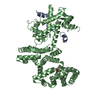
| ||||||||
|---|---|---|---|---|---|---|---|---|---|
| 1 |
| ||||||||
| Unit cell |
|
- Components
Components
| #1: Protein/peptide | Mass: 4667.160 Da / Num. of mol.: 1 Source method: isolated from a genetically manipulated source Source: (gene. exp.)  Homo sapiens (human) / Gene: TP53, P53 / Production host: Homo sapiens (human) / Gene: TP53, P53 / Production host:  | ||||
|---|---|---|---|---|---|
| #2: Protein | Mass: 57376.195 Da / Num. of mol.: 1 / Mutation: A238E Source method: isolated from a genetically manipulated source Details: A single chain S100P is fused to a annexin A2 molecule. Source: (gene. exp.)  Homo sapiens (human) / Gene: S100P, S100E, ANXA2, ANX2, ANX2L4, CAL1H, LPC2D / Production host: Homo sapiens (human) / Gene: S100P, S100E, ANXA2, ANX2, ANX2L4, CAL1H, LPC2D / Production host:  | ||||
| #3: Chemical | ChemComp-GOL / | ||||
| #4: Chemical | ChemComp-CA / #5: Water | ChemComp-HOH / | Has ligand of interest | N | |
-Experimental details
-Experiment
| Experiment | Method:  X-RAY DIFFRACTION / Number of used crystals: 1 X-RAY DIFFRACTION / Number of used crystals: 1 |
|---|
- Sample preparation
Sample preparation
| Crystal | Density Matthews: 2.61 Å3/Da / Density % sol: 52.86 % / Description: Needles |
|---|---|
| Crystal grow | Temperature: 293 K / Method: vapor diffusion, hanging drop Details: Morpheus screen (MD) H6 0.1 M Amino acids, 0.1 M Buffer System 2, pH 7.5, 30 % v/v Precipitant Mix 2 |
-Data collection
| Diffraction | Mean temperature: 100 K / Serial crystal experiment: N | ||||||||||||||||||||||||||||||||||||||||||||||||||||||||||||||||||||||||||||||||||||||||||||||||||||||||||||||||||||||||||||||||||||||||||||||||||||||||||||||||||||||||||||||||||||||||||||||||||||||||||||||||||
|---|---|---|---|---|---|---|---|---|---|---|---|---|---|---|---|---|---|---|---|---|---|---|---|---|---|---|---|---|---|---|---|---|---|---|---|---|---|---|---|---|---|---|---|---|---|---|---|---|---|---|---|---|---|---|---|---|---|---|---|---|---|---|---|---|---|---|---|---|---|---|---|---|---|---|---|---|---|---|---|---|---|---|---|---|---|---|---|---|---|---|---|---|---|---|---|---|---|---|---|---|---|---|---|---|---|---|---|---|---|---|---|---|---|---|---|---|---|---|---|---|---|---|---|---|---|---|---|---|---|---|---|---|---|---|---|---|---|---|---|---|---|---|---|---|---|---|---|---|---|---|---|---|---|---|---|---|---|---|---|---|---|---|---|---|---|---|---|---|---|---|---|---|---|---|---|---|---|---|---|---|---|---|---|---|---|---|---|---|---|---|---|---|---|---|---|---|---|---|---|---|---|---|---|---|---|---|---|---|---|---|---|
| Diffraction source | Source:  SYNCHROTRON / Site: SYNCHROTRON / Site:  SLS SLS  / Beamline: X06SA / Wavelength: 1 Å / Beamline: X06SA / Wavelength: 1 Å | ||||||||||||||||||||||||||||||||||||||||||||||||||||||||||||||||||||||||||||||||||||||||||||||||||||||||||||||||||||||||||||||||||||||||||||||||||||||||||||||||||||||||||||||||||||||||||||||||||||||||||||||||||
| Detector | Type: DECTRIS EIGER X 16M / Detector: PIXEL / Date: Dec 17, 2020 | ||||||||||||||||||||||||||||||||||||||||||||||||||||||||||||||||||||||||||||||||||||||||||||||||||||||||||||||||||||||||||||||||||||||||||||||||||||||||||||||||||||||||||||||||||||||||||||||||||||||||||||||||||
| Radiation | Protocol: SINGLE WAVELENGTH / Monochromatic (M) / Laue (L): M / Scattering type: x-ray | ||||||||||||||||||||||||||||||||||||||||||||||||||||||||||||||||||||||||||||||||||||||||||||||||||||||||||||||||||||||||||||||||||||||||||||||||||||||||||||||||||||||||||||||||||||||||||||||||||||||||||||||||||
| Radiation wavelength | Wavelength: 1 Å / Relative weight: 1 | ||||||||||||||||||||||||||||||||||||||||||||||||||||||||||||||||||||||||||||||||||||||||||||||||||||||||||||||||||||||||||||||||||||||||||||||||||||||||||||||||||||||||||||||||||||||||||||||||||||||||||||||||||
| Reflection | Resolution: 2.1→47.636 Å / Num. obs: 38715 / % possible obs: 99.9 % / Redundancy: 11.636 % / Biso Wilson estimate: 46.417 Å2 / CC1/2: 0.998 / Rmerge(I) obs: 0.126 / Rrim(I) all: 0.132 / Χ2: 0.902 / Net I/σ(I): 22.47 / Num. measured all: 450497 / Scaling rejects: 58 | ||||||||||||||||||||||||||||||||||||||||||||||||||||||||||||||||||||||||||||||||||||||||||||||||||||||||||||||||||||||||||||||||||||||||||||||||||||||||||||||||||||||||||||||||||||||||||||||||||||||||||||||||||
| Reflection shell | Diffraction-ID: 1
|
- Processing
Processing
| Software |
| |||||||||||||||||||||||||||||||||||||||||||||||||||||||||||||||||||||||||||||||||||||||||||||||||||||||||||||||||||||||||||||
|---|---|---|---|---|---|---|---|---|---|---|---|---|---|---|---|---|---|---|---|---|---|---|---|---|---|---|---|---|---|---|---|---|---|---|---|---|---|---|---|---|---|---|---|---|---|---|---|---|---|---|---|---|---|---|---|---|---|---|---|---|---|---|---|---|---|---|---|---|---|---|---|---|---|---|---|---|---|---|---|---|---|---|---|---|---|---|---|---|---|---|---|---|---|---|---|---|---|---|---|---|---|---|---|---|---|---|---|---|---|---|---|---|---|---|---|---|---|---|---|---|---|---|---|---|---|---|
| Refinement | Method to determine structure:  MOLECULAR REPLACEMENT MOLECULAR REPLACEMENTStarting model: 1XJL Resolution: 2.1→47.636 Å / SU ML: 0.25 / Cross valid method: THROUGHOUT / σ(F): 1.35 / Phase error: 23.04 / Stereochemistry target values: ML
| |||||||||||||||||||||||||||||||||||||||||||||||||||||||||||||||||||||||||||||||||||||||||||||||||||||||||||||||||||||||||||||
| Solvent computation | Shrinkage radii: 0.9 Å / VDW probe radii: 1.11 Å / Solvent model: FLAT BULK SOLVENT MODEL | |||||||||||||||||||||||||||||||||||||||||||||||||||||||||||||||||||||||||||||||||||||||||||||||||||||||||||||||||||||||||||||
| Displacement parameters | Biso max: 117.21 Å2 / Biso mean: 49.0082 Å2 / Biso min: 24.16 Å2 | |||||||||||||||||||||||||||||||||||||||||||||||||||||||||||||||||||||||||||||||||||||||||||||||||||||||||||||||||||||||||||||
| Refinement step | Cycle: final / Resolution: 2.1→47.636 Å
| |||||||||||||||||||||||||||||||||||||||||||||||||||||||||||||||||||||||||||||||||||||||||||||||||||||||||||||||||||||||||||||
| LS refinement shell | Refine-ID: X-RAY DIFFRACTION / Rfactor Rfree error: 0 / % reflection obs: 100 %
| |||||||||||||||||||||||||||||||||||||||||||||||||||||||||||||||||||||||||||||||||||||||||||||||||||||||||||||||||||||||||||||
| Refinement TLS params. | Method: refined / Refine-ID: X-RAY DIFFRACTION
| |||||||||||||||||||||||||||||||||||||||||||||||||||||||||||||||||||||||||||||||||||||||||||||||||||||||||||||||||||||||||||||
| Refinement TLS group |
|
 Movie
Movie Controller
Controller




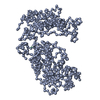
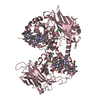


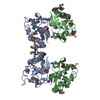
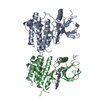
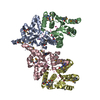

 PDBj
PDBj


























